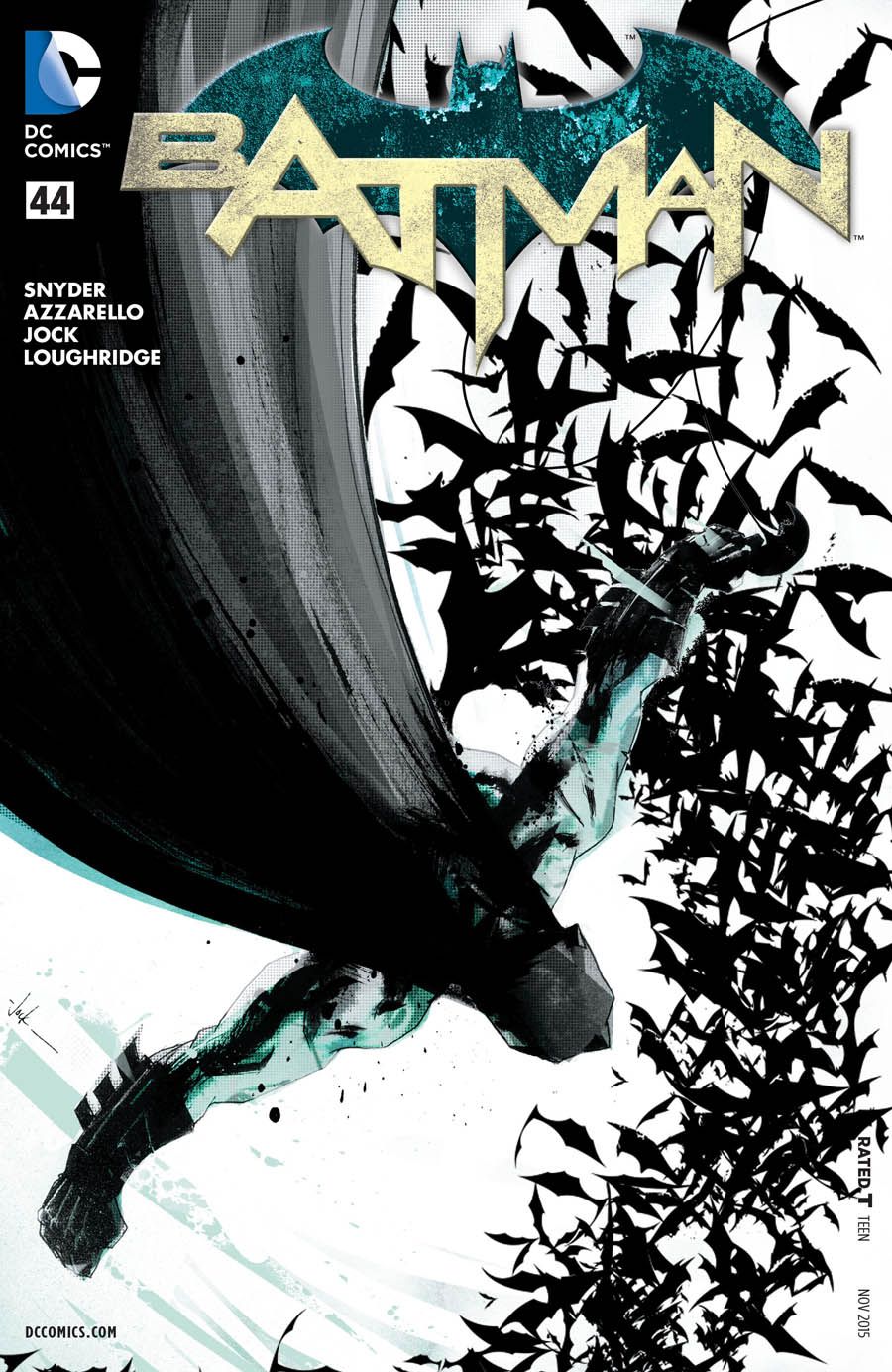"Batman" #44 isn't your typical issue of the series, and I like that. Scott Snyder is joined by his "Detective Comics" co-conspirator Jock, co-scripter Brian Azzarello and colorist Lee Loughridge for a step back in time to just after "Zero Year" ended and Gotham was pulling itself back together for a story where Batman hunts for a killer and finds a more disturbing truth.
What's nice about "Batman" #44's basic structure is that, at first, it feels like a very standard story. Batman tries to find who killed Peter Duggio, a teenage boy whose body was found abandoned in the Gotham marshes just outside the city limits. It's a mystery in need of solving, with Duggio having been dropped from over a thousand feet up in the air with no obvious or immediate suspect. Snyder and Azzarello bring us through a trail of investigation, with Batman moving from one suspect to the next as each points him in a slightly different direction.
Where "Batman" #44 differs is as much in the storytelling technique as it is in the cause of death. Interspersed throughout the panels are excerpts from an article in the "Gotham Gazette," one that helps fully set the scene for what life is like in Gotham for people who don't have Bruce Wayne's resources. It's as much a map of Gotham City as it is a story of the people who live within it, relaying everything from downtrodden neighborhoods to police shooting statistics, all in bits and pieces. Once you keep in mind that this is a time when Bruce Wayne had just become Batman and returned to Gotham City, the timing of this story makes perfect sense. This is an important piece in the evolution of the modern Batman, as he shifts from being a specter that's glimpsed out of the corner of your eye into someone who has greater interaction among those in his city. Similarly, the work that Wayne Enterprises is doing -- like the mentions of Wayne Apartments as a low-incoming housing project being built to try and help rise people out of poverty -- is shown to be only the tip of the iceberg, something that needs a more human face at its front. This is a time when Bruce Wayne was so obsessed with his new persona of Batman that he misses those in desperate need of help right in front of him.
"Batman" #44 is a grim and slightly depressing story, and that's in part thanks to Jock and Loughridge. From that opening page all the way to the conclusion, Jock and Loughridge serve up a bleak setting of a city and a world that's still healing. The image of Duggio's body sprawled in the expanses of the marsh plays with negative space, surrounded by nothing even with the Gotham skyline far away on the horizon. The opening feels isolated and quiet, which is no small feat for a comic. From the shadows of the birds flying away to the dull beige of the swamplands, everything is crafted carefully here.
Jock takes the crazier moments of the comic and brings them a real sense of humanity. The Penguin in the cage seems absurd, but there's something about his sneering face and the shift to a panel zoomed in tightly on his widening eye that makes you feel disdain and then pity for the guy. The fight in the convenience store is another glimpse of humanity on display here, from a look of pure rage after crashing through the racks to the sudden expression of fear as the flickering flames are reflected off of a character's face a page later. It helps you understand just what a state our deceased young man was in, and the lengths to which he was willing to go in order to find help. The most stunning moment in the comic, though, is the two page grayscale spread where Batman stands over his city and the way letterer Deron Bennett carefully overlays excerpts from the article all throughout it. It's almost overwhelming as everything we've learned about Gotham and its people washes over both us and Batman, all the while seeing its buildings and waterways rise up and spread out across the page. It's a truly epic moment.
"Batman" #44 ties carefully into the current storyline running in the series; this isn't merely a flashback for the heck of it. Mr. Bloom's earliest moves are part of this story, and you see just how long he's been working on his transformative seeds. Even more importantly, it's an indirect look at the state of present-day Bruce Wayne as he volunteers with disadvantaged youths, drawing a comparison to the Bruce Wayne moving through this story. There's a strong connection between them, with the current Bruce understanding how to help in a way that Batman was unable to do so in this time period. Snyder, Azzarello, Jock and Loughridge should be proud of what they've done here. What could have been a throwaway issue turns out to be the cornerstone of not only the current storyline, but Snyder's "Batman" run to date. Every extra page in this issue is used with great effect; this is how you pull off an over-sized issue. Very well done.

